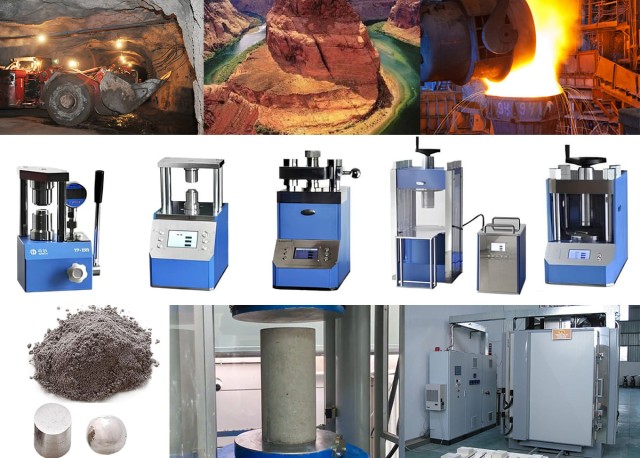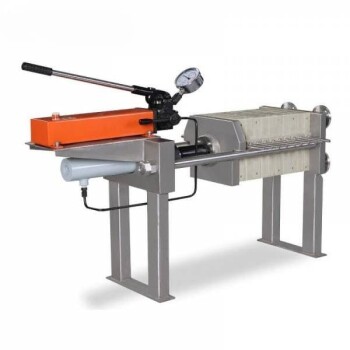The Concept of Hydraulic Press and its Origin
Table of Contents
The description and invention of the hydraulic press, also known as the Bramah Press
A hydraulic press is a compression device that makes use of an exerted force placed upon a fluid, to create a resulting force according to Pascal’s Law. It was actually invented by Joseph Bramah, so is also known as the Bramah Press.
Pascal’s Law is a theory which states that the pressure (P) in a confined fluid, caused by a force (F1), over an area (A1), is transmitted undiminished, causing a force (F2), over the area (A2). This law can be applied to magnify a small force by the ratio of the areas to give a larger force – F2 = F1 (A2/A1).
Hydraulic presses are commonly used for laboratory research and testing. This includes pressing KBr pellets for FTIR (Fourier transform infrared spectroscopy), or general sample pellets for XRF (X-ray fluorescence).
To get accurate results from these tests, it’s important to use the right equipment. This is why hydraulic presses are available in numerous sizes and configurations – but with so many models to choose from, selecting the right machine for your application can prove difficult.
Hydraulic presses, in particular, are used in a wide range of industries to assemble, bend, crush, or otherwise alter the shapes of materials. A hydraulic press — also known as a Bramah press — is a machine that uses synthetic, water, or petroleum-based fluids to move a cylinder for the purpose of generating a compressive force.

A hydraulic press consist of a hydraulic cylinder powered by a pump and a bed or a frame, which holds the die and the material to be pressed. Hydraulic presses are versatile and efficient machines that play a crucial role in many industrial processes, including metalworking, plastics processing, and woodworking. They can be used to perform operations such as forging, punching, blanking, deep drawing, and forming. Hydraulic presses are available in different sizes, capacities, and configurations, depending on the application's specific requirements. Some hydraulic presses have multiple cylinders and a complex control system, while others are simple, single-cylinder presses.
Introduction to Pascal's Law and its Relation to Hydraulic Press
Explanation of Pascal's Law
Pascal's Law is a theory that states the pressure (P) in a confined fluid, caused by a force (F1), over an area (A1), is transmitted undiminished, causing a force (F2), over the area (A2). This law can be applied to magnify a small force by the ratio of the areas to give a larger force – F2 = F1 (A2/A1).
The application of Pascal's Law in a hydraulic press
A hydraulic press is a compression device that makes use of an exerted force placed upon a fluid to create a resulting force according to Pascal's Law. In a hydraulic press, a modest mechanical force (F1) is applied to a small area (A1). As the fluid is moved in one location, it inevitably moves elsewhere within that channel. Then a larger area (A2) generates a magnified mechanical force (F2). The force is transmitted via hydraulic pressure generated by the initial effort, F1.

A hydraulic press uses an oil-filled hydraulic cylinder to generate a compressive force on a movable piston. The machine works using the principle of Pascal's law, which states that the pressure exerted on a fluid is transmitted evenly throughout that fluid. The force generated by the press is proportional to the area of the piston, multiplied by the applied pressure.
A hydraulic press can have many applications. Usually, a laboratory hydraulic press will be used to prepare samples for analysis by compressing them into pellets or thin films. The particles are forced together, creating a homogeneous sample ideal for spectroscopic examination.
One example of a hydraulic press is the KINTEK Manual Hydraulic Press, which is a classic example of the Press. The user applies pressure by hand, using a handle to pump pressure into the hydraulic fluid system. This pressure is transferred to a secondary area, and the resulting force can be as great as 25 tons.
There are different types of hydraulic presses available, including laboratory presses in various sizes and configurations, such as manual or automated operation. Choosing the right hydraulic press for your lab will depend on its intended application and the amount of time and energy your technicians will expend on using it.
Overall, Pascal's Law plays a crucial role in the functioning of a hydraulic press, allowing for the amplification of force through the transmission of hydraulic pressure. This technology has numerous applications in various industries, particularly in laboratories for sample preparation and analysis.
Applications of a Hydraulic Press
Common uses of a laboratory hydraulic press
A laboratory hydraulic press is a smaller version of an industrial hydraulic press that is used for research and testing purposes. It offers more precision and control compared to larger presses. Some common uses of a laboratory hydraulic press include:
- Testing the strength and durability of materials
- Investigating the effects of high pressure on different substances
- Creating pellets for sample analysis
An example of how the KINTEK Manual Hydraulic Press operates
The KINTEK Manual Hydraulic Press is a manual press that uses a hand-operated lever to pump oil and apply load to a sample. It is commonly used for FTIR (Fourier transform infrared spectroscopy), KBr (potassium bromide), and XRF (X-ray fluorescence) sample preparation. The press has a sturdy frame, a lever arm for applying pressure, and a gauge for measuring force and pressure during sample preparation. It does not have any electronic components, making it an affordable option compared to automatic presses.

The role of hydraulic press in FTIR spectroscopy and compositional determination
FTIR spectroscopy is an analytical technique that uses samples prepared by a hydraulic press. KBr (potassium bromide) is often mixed with ground samples and compressed into pellets using a hydraulic press. These pellets are then used for infrared spectroscopic analysis. Similarly, suitable powder mixtures can be compressed to form pellets for compositional determination. The hydraulic press applies an evenly distributed pressure over the sample, transforming refractive material into transparent films that can be used for spectroscopic analysis.
Explanation of the 'pellet die' process
To make a pellet, the sample is mixed with potassium bromide and ground to a fine powder. The powder is then placed inside a durable container called a 'pellet die'. The hydraulic press is used to apply a load of several tonnes to the plunger of the pellet die, compressing the sample into a solid disc. This disc can then be placed inside a spectrometer for examination. The hydraulic press makes the process of producing these discs quick, easy, and repeatable, ensuring reliable and efficient test conditions.

Use of hydraulic presses in tension testing
Hydraulic presses are also used in tension testing, where samples are pulled apart to measure their strength and durability. This process is commonly used in industries such as automotive, aerospace, and construction to ensure the quality and safety of materials. Hydraulic presses provide the necessary force to apply tension to the samples and accurately measure their performance.
In summary, hydraulic presses have various applications in different industries and laboratory settings. They are used for sample preparation in spectroscopy, tension testing of materials, and creating pellets for analysis. The KINTEK Manual Hydraulic Press is a reliable and affordable option for FTIR, KBr, and XRF sample preparation. Its manual operation allows for precise control and measurement of force and pressure during sample preparation.
Different Varieties of Hydraulic Presses offered by KINTEK
Description of different types of powered and manual hydraulic presses available at KINTEK
KINTEK offers a wide range of hydraulic presses to cater to various industrial and research needs. These presses can be categorized into two types: powered (electric) hydraulic presses and manual hydraulic presses.
Powered Hydraulic Presses
The powered hydraulic presses provided by KINTEK are designed to meet the demands of different applications. They come in two variations - with or without LED touchscreens and custom programmable loads. These presses are ideal for industries or research facilities that require the production of a large volume of identical products or pellets.

Manual Hydraulic Presses
KINTEK also offers manual hydraulic presses that can be either full-size or handheld. These presses are suitable for laboratories or facilities with limited space. Despite their smaller footprint, they offer the same level of customization and high quality as larger presses.
The benchtop press range from KINTEK includes both automatic and hand-operated models, providing greater flexibility and customization options for specific tasks. These presses are perfect for applications such as pelletizing, fluid extraction, pressure forming, destructive testing, and more.
Choosing the Right Hydraulic Press
Selecting the right hydraulic press for your laboratory application is crucial to ensure accurate and reliable results. With the wide range of sizes and configurations available, finding the perfect press can be overwhelming. However, KINTEK is here to help.
KINTEK offers a diverse selection of hydraulic presses, ensuring that you can find the ideal press to suit your specific needs. Whether you require a powered hydraulic press for high-volume production or a manual hydraulic press for smaller tasks, KINTEK has got you covered. With their expertise and guidance, you can achieve precise and repeatable results in your research processes.
If you are interested in our products, please visit our company website, where innovation has always been a priority. Our R&D team consists of experienced engineers and scientists who closely follow industry trends and are constantly pushing the boundaries of what is possible. Our laboratory equipment incorporates the latest technology to ensure that you can obtain accurate and repeatable results during your experiments. From high-precision instruments to intelligent control systems, our products will provide you with unlimited possibilities for your experimental work.
Related Products
- Laboratory Hydraulic Pellet Press for XRF KBR FTIR Lab Applications
- Laboratory Manual Hydraulic Pellet Press for Lab Use
- Laboratory Manual Hydraulic Pellet Press for Lab Use
- Manual Lab Heat Press
- 24T 30T 60T Heated Hydraulic Press Machine with Heated Plates for Laboratory Hot Press
Related Articles
- The Benchtop KBr Pellet Press: An Efficient Tool for Laboratory Use
- Comprehensive Guide to Manual Hydraulic Pellet Press
- Automatic Hydraulic Press: The Ultimate Guide for Efficient Sample Preparation and Industrial Processes
- Understanding Hydraulic Pellet Press: Working Mechanism and Applications
- Manual Hydraulic Pellet Press: An Efficient Tool for Spectral Analyses Preparation














